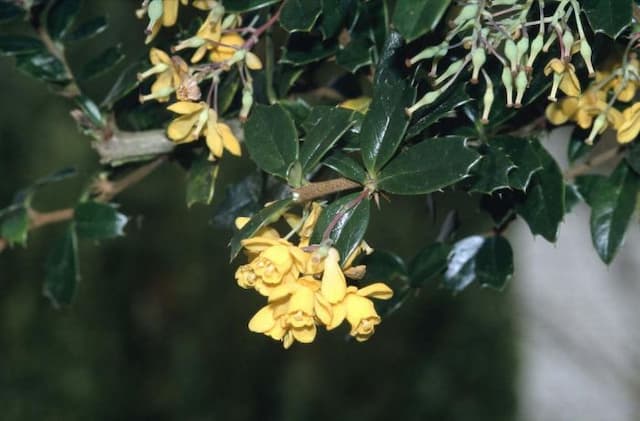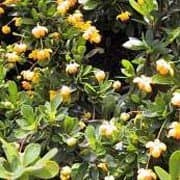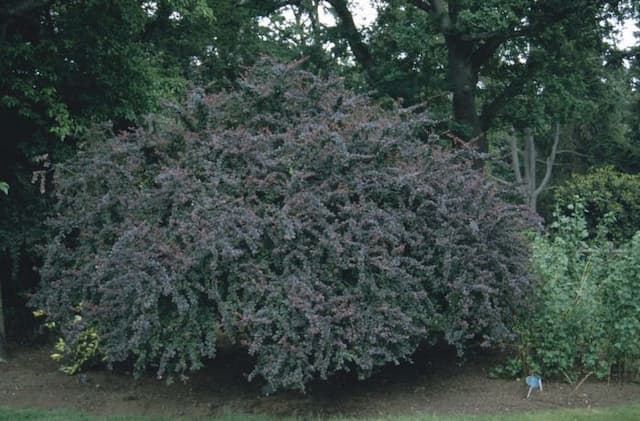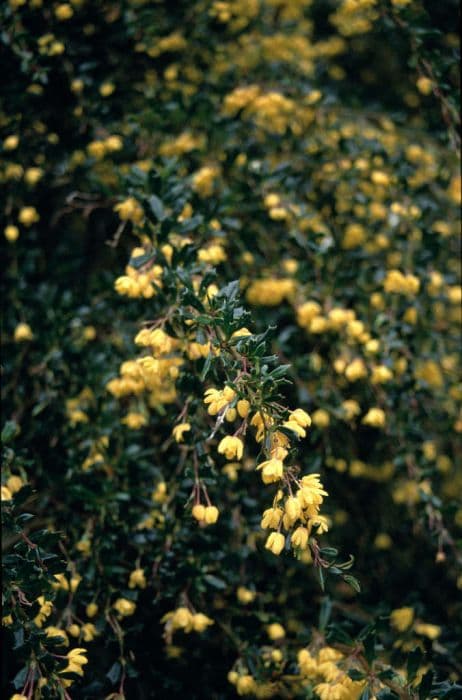Maharajah Barberry Mahonia napaulensis 'Maharajah'

ABOUT
The Mahonia napaulensis 'Maharajah', commonly known as Maharajah, is a striking ornamental plant, distinguished by its bold and textured foliage alongside its visually arresting winter blooms. The leaves have a pinnate form, composed of multiple leaflets arranged on either side of a central stem. Each leaflet is spiky and holly-like in shape, exhibiting an attractive dark green color that can take on purplish or reddish hues in colder temperatures. These evergreen leaves provide year-round interest and contribute to the plant's architectural quality. When the colder months arrive, the Maharajah becomes a focal point with its bright yellow flowers that form in dense, upright clusters. These blossoms add a vibrant contrast against the darker foliage and can attract an array of pollinators. Following the floral display, the plant produces blue-black berries, which stand out against the leaves and can provide food for birds and other wildlife. The overall aspect of Maharajah is robust and sturdy, with a natural vigor that makes it well-suited for adding structure to garden spaces. It possesses a stately elegance that can come to define the area in which it is planted, making the Maharajah an alluring choice for those looking to enhance their landscapes with a plant of year-round decorative appeal.
About this plant
 Names
NamesFamily
Berberidaceae
Synonyms
Maharajah Oregon Grape, Nepalese Mahonia, Maharajah Barberry
Common names
Berberis nepalensis, Mahonia nepalensis.
 Toxicity
ToxicityTo humans
The common name for Mahonia napaulensis 'Maharajah' is Maharajah mahonia. This plant is not typically known for being highly toxic to humans. However, as with many plants, sensitivity can vary between individuals and some parts of the plant may cause mild stomach upset if ingested. Symptoms of ingesting mahonia may include nausea, vomiting, and diarrhea. Its berries, if eaten in large quantities, may lead to these gastric disturbances. Additionally, contact with the spiny leaves may cause skin irritation or a rash in sensitive individuals. It is always advisable to exercise caution and avoid ingesting parts of ornamental plants without proper knowledge of their edibility and potential effects.
To pets
The common name for Mahonia napaulensis 'Maharajah' is Maharajah mahonia. Maharajah mahonia is generally not considered highly toxic to pets, but it can cause some forms of irritation or mild discomfort if ingested. Pets, particularly dogs and cats, might experience symptoms such as vomiting, diarrhea, or drooling if they consume parts of the plant. The spiny leaves might also cause physical irritation to the mouth and gastrointestinal tract. As with any non-food plant, it is a good practice to prevent pets from ingesting it to avoid any potential adverse reactions.
 Characteristics
CharacteristicsLife cycle
Perennials
Foliage type
Evergreen
Color of leaves
Green
Flower color
Yellow
Height
6 feet (1.8 meters)
Spread
4 feet (1.2 meters)
Plant type
Shrub
Hardiness zones
7
Native area
Himalayas
Benefits
 General Benefits
General Benefits- Ornamental Value: Adds visual interest to gardens with its striking foliage and yellow flowers.
- Wildlife Attraction: Berries provide food for birds and flowers can attract pollinators like bees and butterflies.
- Drought Tolerance: Once established, it is relatively drought-resistant, requiring minimal watering.
- Shade Tolerance: Can grow in partially shaded areas where other plants might not thrive.
- Deer Resistance: Less palatable to deer, reducing the likelihood of damage in areas with deer populations.
- Low Maintenance: Requires minimal pruning and care once established in a suitable location.
- Year-round Interest: Evergreen foliage provides visual interest throughout all seasons.
- Easy Propagation: Can be propagated by seeds or cuttings, allowing for easy multiplication of plants.
- Erosion Control: The root system can help stabilize slopes and prevent soil erosion.
 Medical Properties
Medical PropertiesThis plant is not used for medical purposes.
 Air-purifying Qualities
Air-purifying QualitiesThis plant is not specifically known for air purifying qualities.
 Other Uses
Other Uses- Mahonia napaulensis 'Maharajah', commonly known as Maharajah Mahonia, can be used as a natural dye source, with its berries creating a range of blue and purple hues for textiles.
- The wood of the Maharajah Mahonia is sometimes utilized in small woodworking projects, such as crafting decorative items or handles for tools, due to its density and fine grain.
- The spiny leaves offer a deterrent against animal browsing, making the plant useful for planting in areas where wildlife may be a problem.
- The plant's dense habit can be employed for creating an informal hedge or screen for privacy in gardens and landscapes.
- With the plant's striking foliage and long blooming period, it is also valued as a muse in the art world, featuring in botanical illustrations and garden photography.
- Maharajah Mahonia's bright yellow flowers provide a natural source of pollen and nectar for bees and other pollinators during seasons when such resources may be scarce.
- Its evergreen foliage offers a winter shelter for beneficial insects and small wildlife seeking refuge from cold temperatures.
- The ornamental berries can be used in floral arrangements, both fresh and dried, adding unique texture and color to bouquets and decorative displays.
- Due to its robust growing conditions, Maharajah Mahonia can be used for erosion control on slopes or areas with poor soils where other plants may struggle to establish.
- The plant is sometimes incorporated into sensory gardens, with its various textures and scents providing an immersive experience for visitors with visual impairments.
Interesting Facts
 Feng Shui
Feng ShuiThe plant Mahonia is not used in Feng Shui practice.
 Zodiac Sign Compitability
Zodiac Sign CompitabilityThe plant Mahonia is not used in astrology practice.
 Plant Symbolism
Plant Symbolism- Persistence: Maharajah is known for its toughness and ability to thrive in a variety of conditions, making it a symbol of determination and persistence.
- Protection: The spiky leaves of Maharajah resemble holly, which is often associated with protection and defense, suggesting a protective symbolism for this plant as well.
- Resilience: With its evergreen nature and hardiness, Maharajah embodies resilience and the ability to withstand challenges over time.
- Rejuvenation: The bright yellow flowers that bloom in winter can symbolize hope, rejuvenation, and the promise of brighter days during dark times.
 Water
WaterThe Oregon grape 'Maharajah' requires consistent moisture, especially in dry conditions, but does not tolerate standing water. Generally, water when the top inch of soil begins to feel dry to the touch. Depending on the climate and season, this could mean watering once a week or more frequently during hot, dry spells. It's best to water deeply and less often, rather than shallow and frequent watering. For a newly planted Oregon grape 'Maharajah', water with about 1 to 2 gallons once a week until the plant is established. During the fall and winter, reduce watering as the plant requires less moisture and overwatering can lead to root rot.
 Light
LightThe Oregon grape 'Maharajah' thrives best in partial shade to full sun. However, it is important to protect it from strong, direct afternoon sun, especially in hotter climates, to prevent leaf scorch. An ideal spot is one that receives morning sunlight and dappled shade in the afternoon. It can adapt to various light conditions, but bright, indirect light will promote the best growth and flowering.
 Temperature
TemperatureThe Oregon grape 'Maharajah' is hardy and can endure a range of temperatures. It can survive minimum temperatures down to around 0 degrees Fahrenheit and is comfortable in maximum temperatures up to about 95 degrees Fahrenheit. However, the ideal temperature range for this plant is between 60 to 75 degrees Fahrenheit. Avoid exposing the plant to extreme temperature fluctuations to prevent stress.
 Pruning
PruningPruning the Oregon grape 'Maharajah' is mainly done to remove dead or damaged wood and to shape the plant. Prune in late winter or early spring before new growth begins. This plant can be pruned yearly to maintain a tidy appearance, and it is also a good time to cut back any overly long or leggy branches to encourage more bushy growth. The best time for a more severe pruning, if needed for size reduction or rejuvenation, is also during this dormant period.
 Cleaning
CleaningAs needed
 Soil
SoilHimalayan mahonia thrives in a soil mix that is well-drained, rich in organic matter, and maintains a pH of around 5.5 to 7.0. A mix of two parts garden soil, one part peat moss, and one part perlite or coarse sand is ideal to ensure proper drainage and aeration.
 Repotting
RepottingHimalayan mahonia generally doesn't require frequent repotting and can be done every 2-3 years or when the plant outgrows its pot. It's best to repot during spring or early summer to give the plant time to establish in the new container before the colder months.
 Humidity & Misting
Humidity & MistingHimalayan mahonia prefers moderate to high humidity levels, ideally between 50% and 60%. If the air is too dry, especially indoors during winter, using a humidifier or placing a water tray near the plant can help maintain appropriate humidity levels.
 Suitable locations
Suitable locationsIndoor
Provide bright, indirect light and adequate humidity.
Outdoor
Plant in partial shade in well-draining soil; shelter from strong winds.
Hardiness zone
7-9 USDA
 Life cycle
Life cycleThe 'Maharajah' Mahonia begins as a seed that emerges in spring, developing into a young seedling with a characteristic set of compound leaves. As the seedling matures, it establishes a strong root system and grows vertically, gradually forming a woody stem typical of shrubby mahonias. During its vegetative stage, it produces leathery, pinnate leaves which take on a distinctive reddish or purplish hue in colder temperatures. Once the plant reaches maturity, which can take several years, it develops yellow flower clusters in late winter to early spring, favored by pollinators like bees. Following pollination, these flowers give way to blue-black berries by late summer or autumn, which are often dispersed by birds or gravity, facilitating the spread of seeds for new plant growth. Throughout its life, this slow-growing perennial shrub may undergo periods of dormancy in winter, with a life span that can extend over many years if provided with adequate conditions.
 Propogation
PropogationPropogation time
Spring-Early Summer
The optimal time for propagating Mahonia napaulensis 'Maharajah', commonly known as Maharajah mahonia, is during the late winter or early spring before the plant begins its annual growth cycle. The most popular method for propagating this evergreen shrub is by semi-hardwood cuttings. To do so, take cuttings that are 4 to 6 inches (approximately 10 to 15 centimeters) long from a healthy parent plant. These cuttings should have a few leaves at the top. Remove the lower leaves and dip the base of the cuttings in rooting hormone to encourage root development. Then, plant the cuttings in a well-drained potting mix, ensuring that at least two nodes are buried in the soil. Place the pot in a protected environment with indirect light and maintain consistent moisture without overwatering. Roots typically develop within a few weeks to a few months, after which the young plants can be transplanted to their final location.









